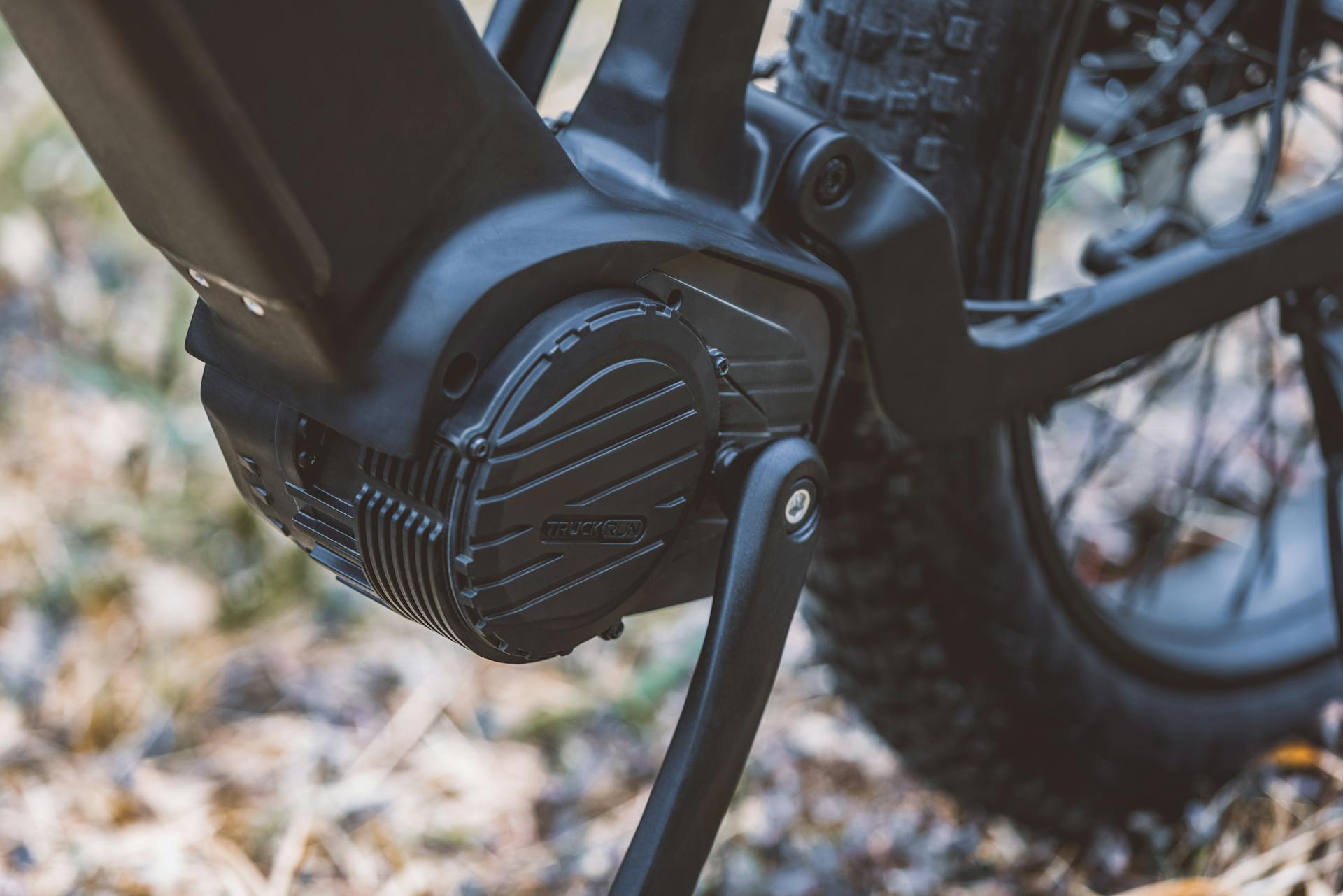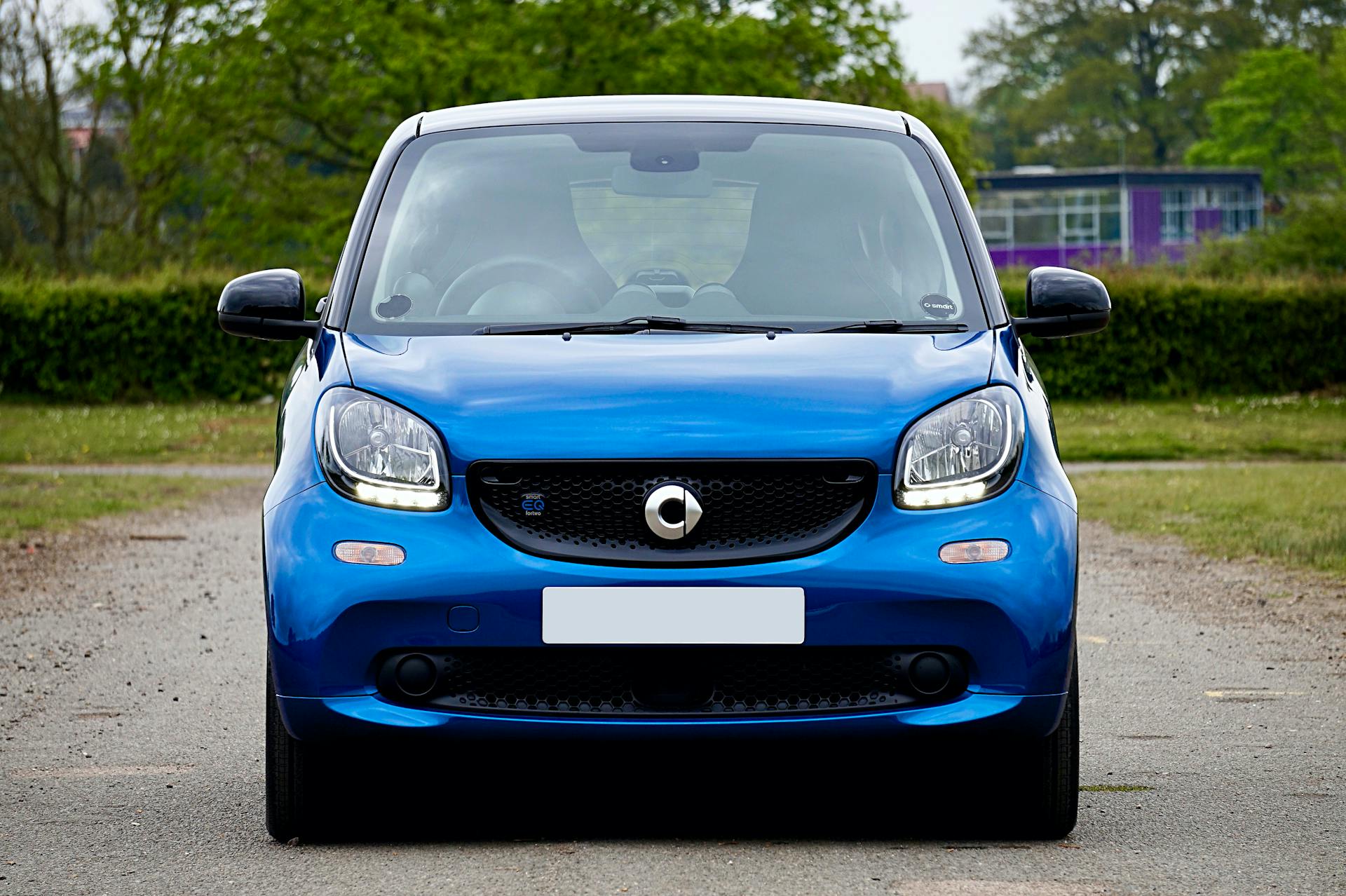
Doubly fed electric machines are widely used in wind power generation due to their high efficiency and reliability. They can operate at variable speeds, which is essential for wind turbines to maximize energy production.
These machines can also be used in other applications, such as hydroelectric power plants, where they provide a reliable and efficient way to generate power.
Principle of Operation
A Doubly Fed Electric Machine (DFIG) is a type of generator that's fed with electrical power on both the rotor and stator sides, allowing for two-way power flow.
This unique design enables the rotor to operate at variable speed, which is a key feature of DFIGs. The rotor winding is connected to the grid via a back-to-back converter, making it possible to control the speed and power flow.
The power flow in a DFIG is described by several key parameters, including Pm, Ps, Pr, and Pgc. These parameters are computed as follows:
In steady-state, the mechanical power and stator electric power output are related by the equation Pm = Ps + Pr. The rotor power output, Pr, is a function of the slip, s, which is defined as (ωs – ωr)/ωs. The sign of Pr depends on the slip sign, with Pr being positive for negative slip and negative for positive slip.
The speed of the wind turbine is determined by the power Pr absorbed or generated by the DC bus capacitor, Crotor. The power control is achieved by adjusting the power flow between the rotor and the grid.
DFIG Components
The Doubly Fed Induction Generator (DFIG) is a crucial component in wind power generation systems. It's a type of electrical generator that converts mechanical energy into electrical energy.
The DFIG is made up of two main parts: the stator and the rotor. The stator is similar to a standard induction generator, consisting of a three-phase winding.
The rotor, on the other hand, is a wound rotor connected to the grid via slip rings and a converter. This design allows for variable speed operation and two-way power flow.
The rotor side converter is a DC-AC inverter that provides controlled AC voltage to the rotor.
Here are the key components of the DFIG system:
- A Wind Turbine: The wind turbine is typically a fan consisting of 3 blades which rotate when wind strikes it.
- Gear Box: It is a high precision mechanical system which uses a mechanical method to convert energy from one device to another.
- Double Fed Induction Generator: It is an electrical generator used to convert mechanical energy to electrical energy which is in form of variable frequency.
- Grid Side Converter: It is an AC-DC converter circuit which is used to provide a regulated DC voltage to the inverter.
- Rotor Side Converter: It is a DC-AC inverter which is used to provide controlled AC voltage to the rotor.
Parameters
The parameters of a doubly fed electric machine are grouped into four categories to make it easier to visualize and understand their relationships.
The WTDFIG parameters are grouped into four categories: Generator data, Converters data, Turbine data, and Control parameters.
Generator data is a crucial category that includes parameters related to the electrical output of the machine.
The Display listbox allows you to select which group of parameters you want to visualize, making it a useful tool for engineers and researchers.
Converters data is another important category that includes parameters related to the conversion of electrical energy.
DFIG Working Mechanism
A Doubly-Fed Induction Generator (DFIG) is a type of electrical generator that's perfect for renewable energy, especially wind energy systems.
The working mechanism of a DFIG is quite fascinating. It involves a rotor that can rotate at different speeds, either faster or slower than the stator magnetic field.
The rotor speed is controlled by adjusting the frequency of the current fed to the rotor winding through the back-to-back converter. This converter also helps in controlling the power factor at which the generator operates.
This unique characteristic makes the DFG a preferred choice for many wind turbine systems.
DFIG Control
DFIG control is a crucial aspect of doubly fed electric machines. The control system consists of measurement systems, an outer regulation loop, and an inner current regulation loop. This setup allows for precise control of the DC voltage, active power flow, and reactive power.
The control system uses a two-axis reference frame model, known as the dq model, to simplify the control of rotor currents. This model is based on Park's transformation and allows for dual control of active and reactive power. The d-axis controls the active power, while the q-axis controls the reactive power.
The magnitude of the reference grid converter current is calculated as the square root of the sum of the squares of the Idgc_ref and Iq_ref components. The maximum value of this current is limited to a value defined by the converter's maximum power at nominal voltage.
A different take: Direct Current Electric Generator
Control Tab
The Control Tab is where you can fine-tune the control of your DFIG. The maximum power of both Cgrid and Crotor in pu of the nominal power is a crucial parameter, used to compute the maximum current at 1 pu of voltage for Cgrid, and is set to 0.5 by default.
You can also specify the initial phasor current in positive-sequence for the coupling inductor, with a magnitude in pu and phase in degrees. If you know the initial value of the current corresponding to the WTDFIG operating point, you can specify it to start the simulation in steady state. Otherwise, you can leave it at the default value of [0 90], and the system will reach steady-state after a short transient.
The nominal DC bus voltage is set to 1200 volts by default, and the total capacitance of the DC link is 10000 microfarads, which is related to the WTDFIG rating and the DC link nominal voltage. This value is used to store energy in the capacitance, and is usually a fraction of a cycle at nominal frequency.
Here's a summary of the default values for the Control Tab:
By adjusting these parameters, you can optimize the control of your DFIG and improve its performance.
Pitch Angle Control
The pitch angle control system is a crucial part of a DFIG control system, ensuring stable and efficient operation.
The pitch angle is kept constant at zero degrees until the speed reaches point D speed of the tracking characteristic. Beyond point D, the pitch angle is proportional to the speed deviation from point D speed.
Only the positive-sequence is taken into account, the negative-sequence has been eliminated.
A trip input has been added to the pitch control system. When this input is high, the induction generator is disconnected from the grid and from Crotor.
This safety feature prevents damage to the system in case of an emergency.
You might enjoy: Remote Control Construction Machines
Advantages and Applications
Doubly fed electric machines, or DFIGs, have some amazing advantages that make them ideal for certain applications. Their flexibility is one of their standout features, allowing them to operate at variable speeds and adapt to fluctuating wind speeds.
DFIGs are particularly efficient, maintaining a high level of efficiency over a wider range of speeds compared to traditional induction generators. This is because power is fed into both the stator and rotor, increasing the generator's ability to convert mechanical power into electrical power.
One of the key benefits of DFIGs is their ability to smoothly connect and disconnect from the grid, ensuring stability and continuity in power supply. This is made possible by the back-to-back converter.
DFIGs are also suitable for other renewable energy systems, including small hydro and tidal energy generation plants. Their flexible and efficient operation makes them a great fit for these applications.
Here are some of the key advantages of DFIGs:
- Flexibility: DFIGs can operate at variable speeds.
- Efficiency: DFIGs can maintain a high level of efficiency over a wider range of speeds.
- Grid Connection: DFIGs can smoothly connect and disconnect from the grid.
Examples and Case Studies
The Doubly Fed Induction Generator (DFIG) is a type of electric machine that's often used in wind farms. A notable example of its application can be seen in the Wind Farm - Doubly-Fed Induction Generator (DFIG) Phasor Model example.
This example illustrates the steady-state and dynamic performance of the WTDFIG in a 9 MW Wind Farm connected on a 25 kV, 60 Hz, system. The DFIG is a key component in this setup, enabling efficient energy production.
The DFIG's performance can be observed in various countries, including Belgium, Denmark, and Finland, where similar wind farm configurations have been implemented.
Suggestion: Induction Generator
Examples

Let's take a look at some real-world examples of wind farms in action. The Wind Farm - Doubly-Fed Induction Generator (DFIG) Phasor Model example is a great illustration of how these systems perform in a 9 MW Wind Farm connected to a 25 kV, 60 Hz system.
The Wind Farm - Doubly-Fed Induction Generator (DFIG) Phasor Model example is based in Europe, with specific locations including Belgium, Denmark, Deutschland, España, Finland, France, Ireland, Italia, and Luxembourg.
EconoDUAL 3
The EconoDUAL 3 module is a game-changer for power density and cycling capability. It's available with IGBT4 and IGBT7 technology, which offers the highest power density and leading-edge power cycling capability.
The portfolio supports a wide range of current, from 450 A up to 900 A at 1700 V. This versatility makes it suitable for various applications.
Additional reading: Capability Curve
Frequently Asked Questions
What is the difference between DFIG and full converter?
A DFIG (Doubly Fed Induction Generator) typically uses one converter for the rotor connection, whereas a full-power converter system uses multiple parallel converters. This design difference affects the system's complexity and scalability.
Featured Images: pexels.com


